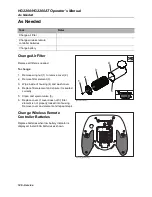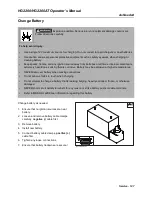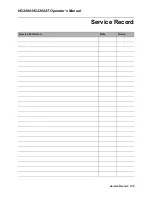
The Tire Information Placard is attached adjacent to or near the trailer’s VIN (Certification) label
at the left front of the trailer.
1.1.2. TRAILERS OVER 10,000 POUNDS GVWR
(NOTE: These trailers are not required to have
a tire information placard on the trailer.)
1. Determine the empty weight of your trailer by weighing the trailer using a public scale or
other means. This step does not have to be repeated.
2. Locate the GVWR (Gross Vehicle Weight Rating) of the trailer on your trailer’s VIN
(Certification) label.
3. Subtract the empty weight of your trailer from the GVWR stated on the VIN label. That
weight is the maximum available cargo capacity of the trailer and must not be exceeded.
1.2. STEPS FOR DETERMINING CORRECT LOAD LIMIT – TOW VEHICLE
1. Locate the statement, “The combined weight of occupants and cargo should never
exceed XXX lbs.,” on your vehicle’s placard.
2. Determine the combined weight of the driver and passengers who will be riding in your
vehicle.
3. Subtract the combined weight of the driver and passengers from XXX kilograms or XXX
pounds.
4. The resulting figure equals the available amount of cargo capacity. For example, if the
“XXX” amount equals 1400 lbs. and there will be five 150 lb. passengers in your vehicle,
the amount of available cargo and luggage capacity is 650 lbs. (1400-750 (5 x 150) = 650
lbs.).
5. Determine the combined weight of cargo being loaded on the vehicle. That weight must
not exceed the available cargo capacity calculated in Step # 4.
6. If your vehicle will be towing a trailer, load from your trailer will be transferred to your
vehicle. Consult the tow vehicle’s manual to determine how this weight transfer reduces
the available cargo and luggage capacity of your vehicle.
1.3. GLOSSARY OF TIRE TERMINOLOGY
Bead - t
he part of the tire that is made of steel wires, wrapped or reinforced by ply cords
and that is shaped to fit the rim.
Bead separation -
the breakdown of the bond between components in the bead.
Bias ply tire -
a pneumatic tire in which the ply cords that extend to the beads are laid at
alternate angles substantially less than 90 degrees to the centerline of the tread.
Carcass -
the tire structure, except tread and sidewall rubber which, when inflated, bears
the load.
Chunking -
the breaking away of pieces of the tread or sidewall.
Cold inflation pressure -
the pressure in the tire before you drive.
Cord -
the strands forming the plies in the tire.
Cord separation -
the parting of cords from adjacent rubber compounds.
Cracking -
any parting within the tread, sidewall, or inner liner of the tire extending to
cord material.
Curb weight -
the weight of a vehicle with standard equipment.
Groove -
the space between two adjacent tread ribs.
Gross Axle Weight Rating (GAWR) -
the maximum weight that any axle can support, as
published on the Certification / VIN label on the front left side of the trailer. Actual weight
determined by weighing each axle on a public scale, with the trailer attached to the
towing vehicle.
Gross Vehicle Weight Rating (GVWR) -
the maximum weight of the fully loaded trailer,
as published on the Certification / VIN label. Actual weight determined by weighing trailer
on a public scale, without being attached to the towing vehicle.
Tongue Weight -
the downward force exerted on the hitch ball or lunette by the trailer
coupler.
Innerliner -
the layer(s) forming the inside surface of a tubeless tire that contains the
inflating medium within the tire.
Summary of Contents for HG2200
Page 51: ...HG2200 HG2200AT Operator s Manual Battery Disconnect 50 Controls ...
Page 75: ...HG2200 HG2200AT Operator s Manual Retrieve Tracked Unit 74 Transport ...
Page 87: ...HG2200 HG2200AT Operator s Manual Finish Installation 86 Burst Pipe ...
Page 129: ...HG2200 HG2200AT Operator s Manual As Needed 128 Service ...
Page 133: ...HG2200 HG2200AT Operator s Manual Declaration of Conformity Information 132 Specifications ...
Page 137: ...HG2200 HG2200AT Operator s Manual 136 Service Record Service Performed Date Hours ...
Page 146: ......
























